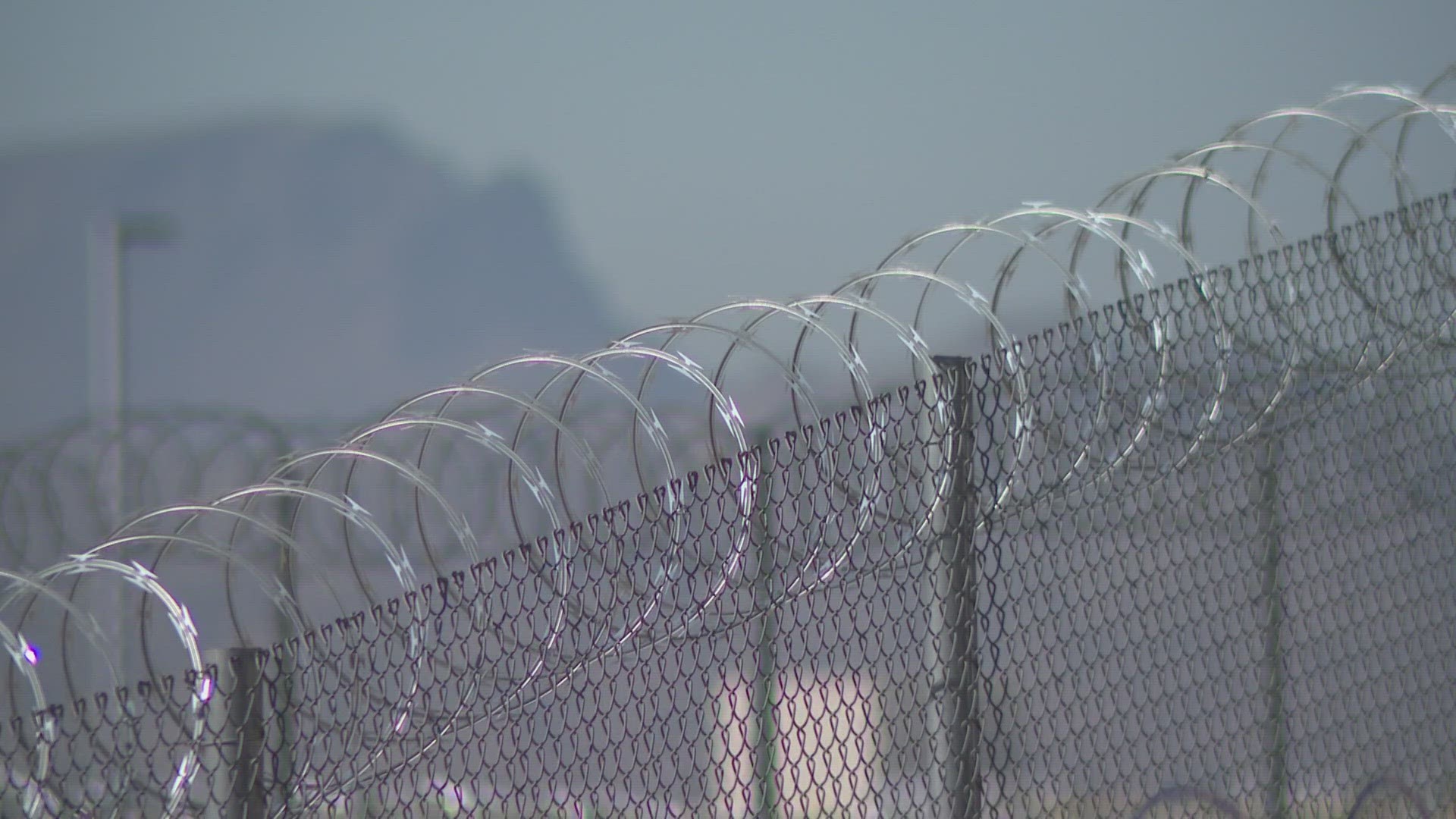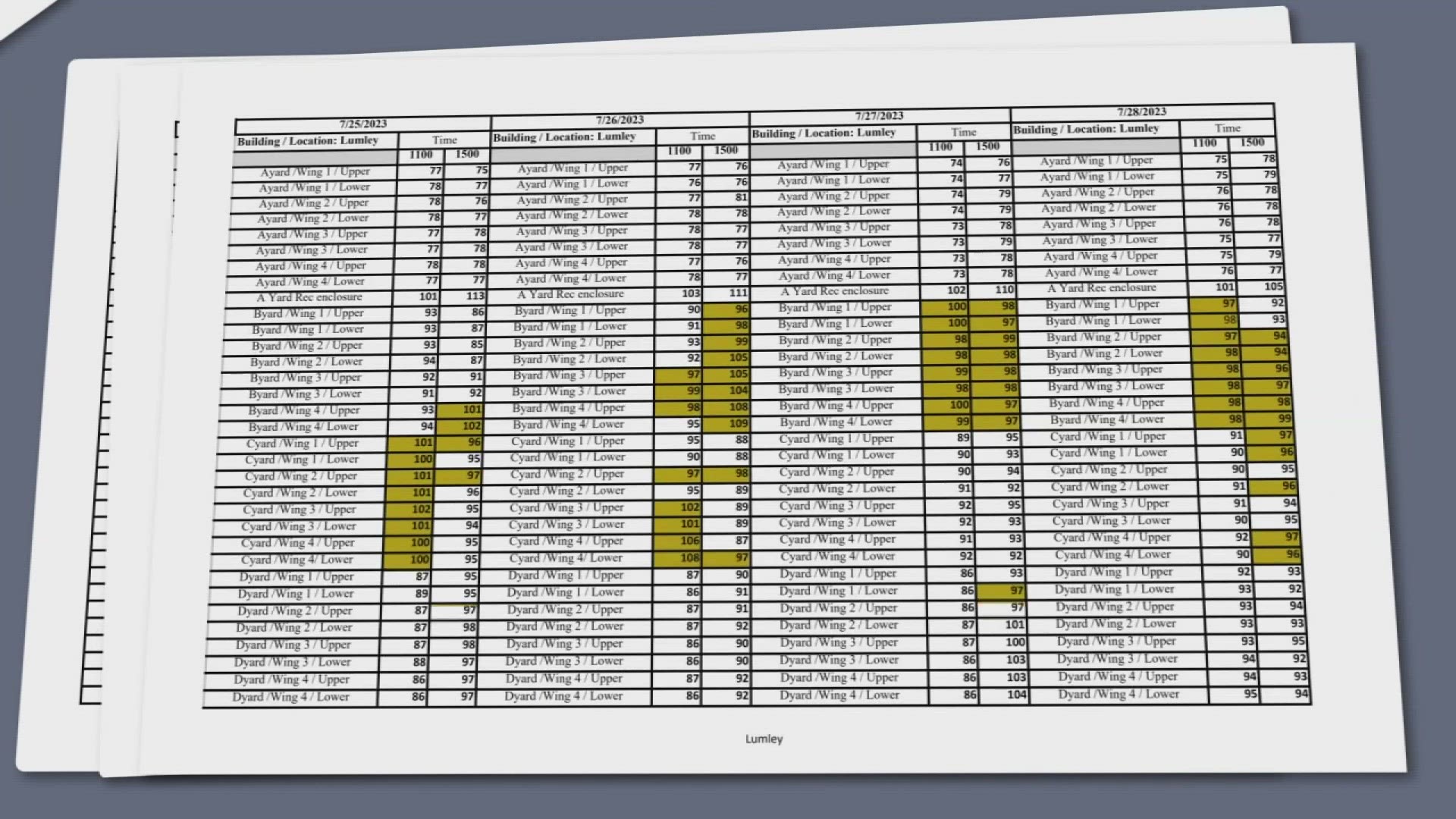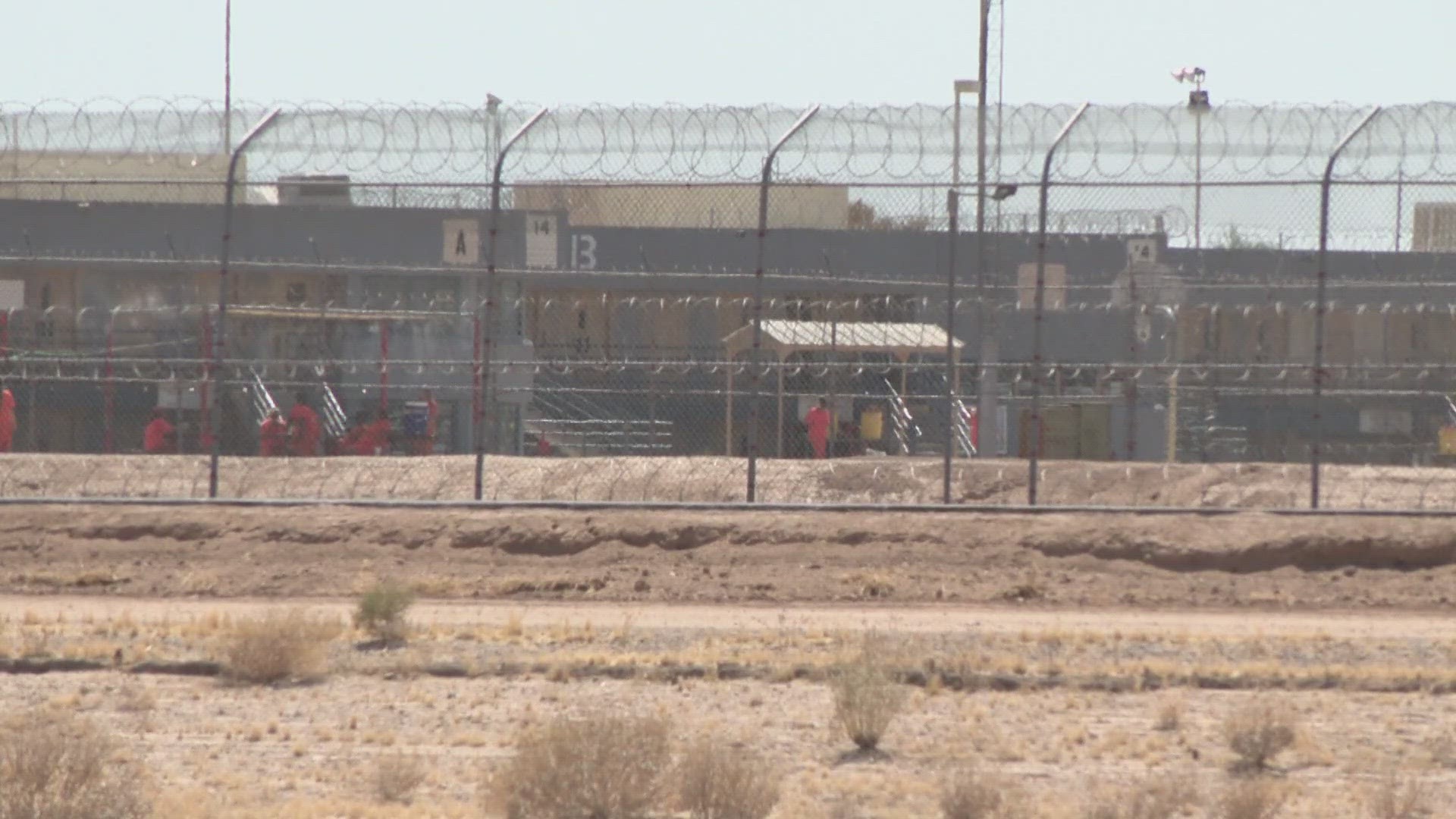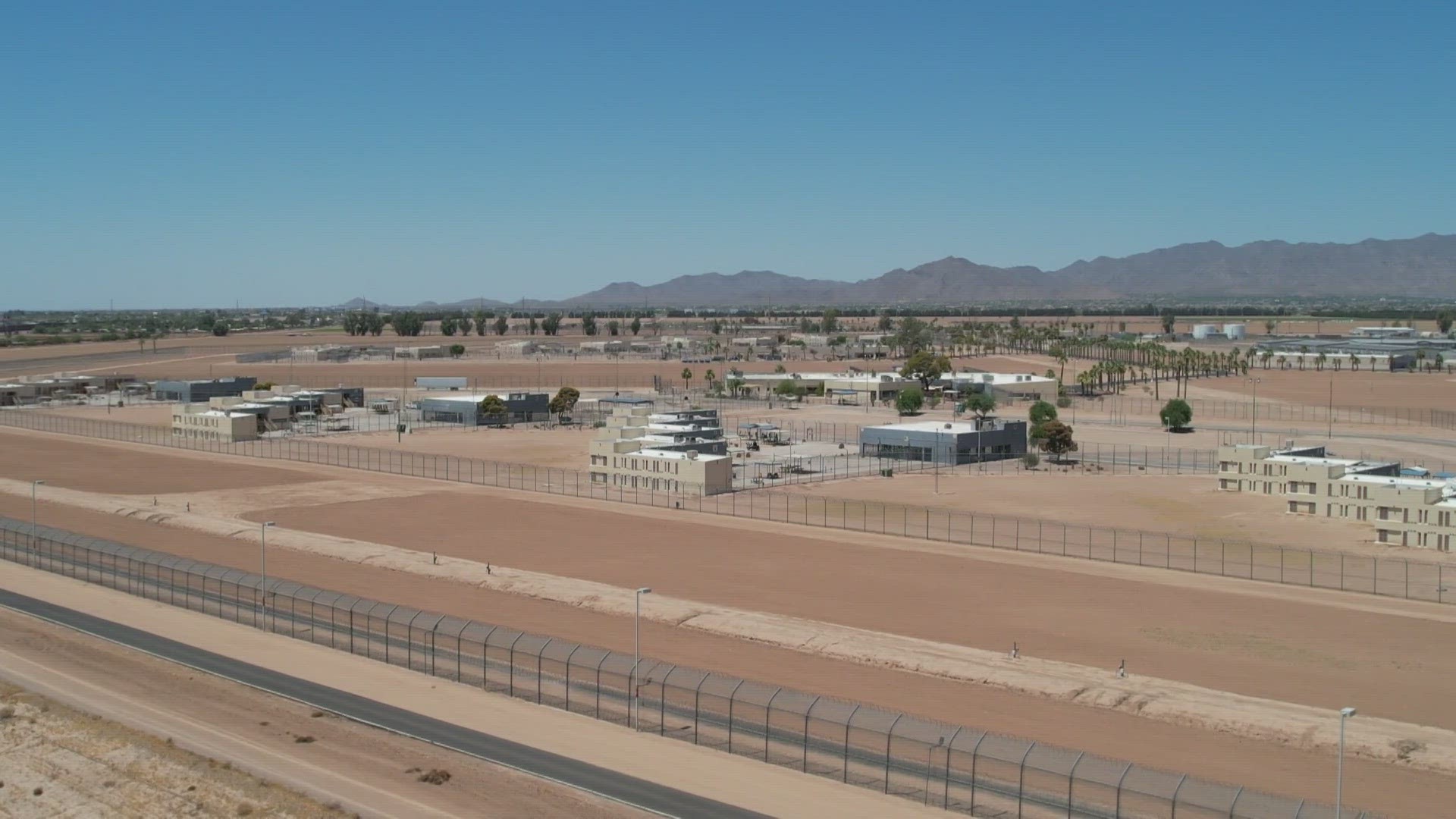GOODYEAR, Ariz. — As the third straight week of temperatures higher than 110 degrees started in the Phoenix area last July, a corrections department employee was outside on the roof at Perryville prison.
The employee was part of a crew that was putting ice in swamp coolers on the Santa Cruz unit of the women’s prison in Goodyear, according to department records, presumably to cool the equipment down. By all accounts, the old equipment has a hard time keeping up in triple-digit temps and could sometimes blow hot air or break down altogether.
But the heat overcame the work crew, who had to cut the project short. The department’s incident report detailed that they began to feel “unwell” and went to the kitchen to cool off. Two inmates and at least two employees were evaluated by medical staff. An ambulance was called for one of the employees who still felt “dizziness” and had high blood pressure readings. That employee ultimately refused further treatment and had to be taken home.
This is one example of how the heat is taking a toll on Arizona prisons. After a series of 12News I-Team reports last summer prompted changes in heat relief at Perryville prison, we wanted to see all the ways heat impacted the facility and what cell temperatures were like statewide.
The hottest prisons in Arizona
It’s no surprise Arizona is hot in the summer. But summer 2023 was record-breaking. Nearly every day in July had a high temperature at or above 110-degrees outdoors. In a prison setting, especially if there aren’t working swamp coolers or air conditioners, there can be little reprieve.
In September, the 12News I-Team requested temperature logs from all of Arizona’s state prisons. We kept our scope narrow in this public records request, asking for the logs from July 2023. The corrections department turned them over in December, three months after they were requested.
Of all 16 prisons in Arizona, the highest indoor temperatures recorded ranged from 88 degrees to 111 degrees inside cells or dorm areas.
- Kingman: 111.2 degrees
- Perryville: 109 degrees
- Lewis: 100 degrees
- Red Rock Correctional Center: 98 degrees
- Florence: 95 degrees
- Phoenix West: 95 degrees
- Eyman: 94 degrees
- Phoenix: 94 degrees
- Tucson: 94 degrees
- Winslow: 92 degrees
- Yuma: 91 degrees
- Central Arizona Corrections Facility: 89 degrees
- Douglas: 88 degrees
- Marana: 88 degrees
- La Palma: Did not keep temperature logs in July 2023
- Safford: Unclear if their facility documented indoor temperatures
The Huachuca Unit at the state prison in Kingman recorded the highest indoor temperature of all prisons, with 111.2 degrees on July 29.
Perryville women’s prison in Goodyear had the second highest, with certain cells hitting as high as 109 degrees. Cells at Perryville hit triple digits on 11 days in July.
Lewis prison in Buckeye also had multiple days where certain cells temped in the 90s – once hitting 100 degrees, according to the logs.
Some facilities, like Douglas and Yuma, consistently recorded cooler temperatures, most days in the 70s and 80s.
“It's unfortunately becoming commonplace in a lot of particularly southern states and Texas where I live,” said Michele Deitch, who leads the Prison and Jail Innovation Lab at the University of Texas at Austin. “I'm not surprised by it. But I'm still horrified that anybody should be asked to live in those kinds of conditions.”
She’s not alone. The I-Team took our findings to three other outside sources to review.
“It’s unacceptable,” said Arizona State Rep. Analise Ortiz. “Period.”
“That is not a safe living condition,” said Noah Barth, the prison monitoring director of the Pennsylvania Prison Society.
“It's important to control these things because of the secure operations of the facility, because of the security of the staff, because of the health implications for the incarcerated people,” said John Fabricius.
Fabricius used to be incarcerated in Arizona’s Department of Corrections, Rehabilitation and Reentry, or ADCRR. He said he served time at nine different complexes over 15 years and was released in 2018. Now, he works for Dream.org and leads Arizonans for Transparency and Accountability in Corrections.
“It's really, really hot,” Fabricius said. “It's really hot in those buildings. It's analogous to locking yourself in your attic or something like that in the summer.”
“Relief is hard to come by?” asked I-Team reporter Erica Stapleton.
“It doesn’t exist,” Fabricius said.
He remembered when he first went into the system in the early 2000s, he said he was sent to Lewis prison and one of his first job assignments was outside raking rocks.
“Basically just straightening the desert rocks out with a rake that were there in the direct sun,” he remembered. “And then you go inside and the heat in there is just unbearably stifling.”
The department published an Excessive Heat Safety and Relief Strategy online on July 19, 2023, the day after we first started reporting on heat concerns in Perryville prison. It said that air-conditioned cooling centers would be available to inmates in heat-impacted housing areas.
The I-Team questioned prison director Ryan Thornell about heat concerns at Perryville on that same day in July. At the time, the director had not recently visited the women’s prison and stated he hadn’t seen any records of triple-digit temperatures in cells.
After the interview, Thornell went to Perryville to check temperatures for himself. Within days misters were installed outside, rules were relaxed and inmates were offered free ice. The prison’s warden also stepped down. Despite the changes made by the department at Perryville, triple-digit temperatures still persisted in some cells, according to the logs.
“That's going to have an incredibly negative impact on both people who are incarcerated there and the people who work there and it's something that the state needs to prioritize in terms of addressing,” Deitch said.
‘This heat is killing me’: Heat hospitalizations at Perryville
The roof incident isn’t the only time people at Perryville needed help in the heat. In a public records request, the department turned over reports from 13 incidents in July 2023 where people – including incarcerated women and corrections staff – reported heat-illness symptoms. Some symptoms detailed in the report include dizziness, heat exhaustion, dehydration and going in and out of consciousness.
On three different occasions, incarcerated women had to be transported out to Abrazo West Campus hospital in Goodyear for further care. Another time a corrections employee had to be transported to the hospital for possible heat exhaustion. The report stated the employee felt sick after doing afternoon temperature checks.
There was also an instance where a corrections employee was sent home after telling a supervisor, “this heat is killing me,” according to the incident report.
“When the state takes away somebody's freedom, it is our obligation to keep them safe,” Ortiz said. “What’s happening with these extreme temperatures shows me that the Department of Corrections was not taking people’s safety seriously at that time. That includes the guards. People that are working in our prisons should not have to go to a workplace where they may be sent to the hospital because it’s too hot.”
Ortiz is on the state’s Independent Prison Oversight Commission, formed last year. She said the Commission heard several complaints of hot temperatures in Arizona’s prisons.
“We were hearing, especially in the women’s prison, that the temperatures were astronomical,” Ortiz shared.
“You're not going to get staff to want to work in a place where it is that miserable in the summers,” Deitch added. “They're wearing heavy uniforms. They are at risk, as well.”
Deitch, Fabricius, Ortiz and Barth all believe the extreme heat has a negative impact on rehabilitation.
“The high temperatures create a very high level of tension among people who are incarcerated,” Deitch explained. “It can lead to violence and outbursts and irritability.”
“If someone is trying to focus on rehabilitating themselves, it becomes so much harder when you are in a very harsh condition or in the heat or angry or in pain,” Ortiz added.
Red flags in record-keeping
The I-Team uncovered more than just hot temperatures when reviewing temperature logs from all facilities.
In July, Arizona had sixteen prisons. The prison in Marana, which was privately operated, closed at the end of 2023. The other fifteen prisons are still operating. Nine of them are operated by the state and six are privately-operated through contracts with the state. The temperature logs show that most facilities checked cell temperatures twice a day in the morning and afternoon.
Of the records we reviewed, none of the prisons used the same paperwork for keeping track of temperatures. Some were handwritten and hard to read. It appeared that the prison in Safford only recorded outdoor temperatures. The warden at La Palma Correctional Center in Eloy admitted they only started doing temperature logs in August and had nothing to show for July.
The records show that the Cerbat Unit at the Kingman prison had the exact same temperature readings down to the decimal point on 11 different days. For example, one dorm area was recorded repeatedly to be 90.2 in the mornings, but each afternoon the temperature would be different, sometimes swinging 20 degrees cooler.
It didn’t make sense and neither the Department of Corrections nor GEO Group, the private company contracted to run the Kingman prison, would explain it.
“A lack of uniformity just raises some questions about how they're going about monitoring temperatures,” said Noah Barth, who also consulted with the Independent Prison Oversight Commission. “The issue you get into, however, is when you don't have consistency of policy, then you can't have consistency of outcomes and expectations of how to address things.”
The ADCRR media relations team has never told the I-Team what the department considers to be excessive heat.
The I-Team did find a corrections department order from 2019 listing a maximum indoor temperature standard at 80 degrees. The I-Team could not find any updated version of this document on the department’s website.
That means every state prison that recorded indoor temperatures in July 2023 would have violated those standards last summer.
“I’d like to see them identify why those cells are so hot, because it seemed that some of them were hotter than others,” Barth said after reviewing our findings. “I think the facility needs to investigate why it is that those temperatures are the way they are and seek to fix them immediately.”
Why are some prison cells so hot?
At Perryville prison, the cells most impacted by triple-digit temperatures were in buildings that are cooled with swamp coolers instead of air conditioners.
“These are secure buildings that are built with concrete and steel,” Fabricius said. “They don’t breathe.”
“The swamp coolers are simply not adequate to handle the temperatures that we're seeing today,” Deitch added.
But some air conditioners aren’t keeping up either, according to findings by the I-Team.
The I-Team looked at maintenance logs from Perryville from July 1-26, 2023. We found that out of more than 250 reports, the department had the most orders for HVAC work.
The records provided to us showed the department spent more than $14,000 in those three weeks on things like A/C filter swaps to total breakdowns of air conditioners and swamp coolers.
In one complaint where swamp coolers reportedly weren’t working, the maintenance worker wrote that the “temps were normal for swamp coolers” with the high temps and high humidity outside.
Another case, staff in the medical unit complained the A/C wasn’t working. The maintenance worker wrote that the door opening and closing all day was a problem and that the equipment was too small for the space and should be replaced when funding is available.
“What does that tell you about the condition of prisons in Arizona?” the I-Team’s Erica Stapleton asked Ortiz.
“It’s clear that the air conditioning systems in our prisons are not up to date,” Ortiz replied.
“It makes me scratch my head,” Fabricius added. “You’re taking a whole bunch of my paycheck every week to pay for this thing. I should know how it’s operating.”
The HVAC work we reviewed in the limited records provided by the department is a drop in the bucket if you look at the correction department's annual budget, which is more than $1 billion.
“The Department of Corrections has more than enough money,” Ortiz said. “They need to reassess and look at their budget and find ways that we can use our tax dollars more efficiently and in a way that keeps people safe.”
A plan to replace the swamp coolers at Perryville with air conditioners is in the state’s budget, but it’s been a slow process. Some familiar with the plans say it’s because the building is old and would need to be retrofitted.
“We're converting HVAC systems all over the state,” prison Director Thornell said in an interview with the I-Team in July. “We have been for the last few years.”
The state put out a solicitation for a $12 million contract at the end of 2023 to replace the swamp coolers at Perryville with A/Cs. State contract records show the bidding closed in early January and the contract is currently “under evaluation.”
“[The Department] originally told lawmakers that they would have all of the air conditioning units updated by the winter of 2024,” Ortiz explained. “But that means people would have to suffer through another brutal summer. So they told us that they will try to expedite things and get everything updated by March of this year.”
For the past six months, the I-Team asked more than a dozen times for a new interview with Director Thornell after his visit to Perryville and after the department released its heat records. The ADCRR Media Relations team declined all interview requests and did not answer any of the I-Team’s questions about the department’s temperature logs or the heat and maintenance records at Perryville prison.
The ADCRR Media Relations team sent the following statement over email:
The safety and well-being of our staff and the people in our custody are of paramount importance to the ADCRR.
To that end, the HVAC project at ASPC-Perryville is ongoing and remains a top priority for our Department.
The architecture and engineering construction documents for upgrading all HVAC units at ASPC-Perryville have been reviewed and approved by ADOA.
The selection of the construction firm tasked with completing the entire project at Perryville will be made later this month (January). Once contractor selection is made and pricing negotiations are complete, the contractor will staff up and mobilize to complete the project at Perryville. The contractor will determine timelines and completion dates for the project.
ADCRR is committed to expediting this HVAC project while adhering to statutory and regulatory requirements.
An update to the department’s Excessive Heat Safety and Relief Strategy online was posted in October 2023. It explained that prison operations would return to normal with cooling temperatures and that the department was “shifting our focus to planning and preparing for next summer’s temperatures in an effort to prevent unbearable heat situations,” but did not outline what those plans are.
“There absolutely needs to be more transparency,” Rep. Ortiz said during our interview. “And I'm sorry that you didn't get a clear answer in the way that you and the public deserve. There has been a long ongoing problem with a lack of transparency within the Department of Corrections, even for families who have loved ones inside.”
“It's wrong,” Ortiz added. “The purpose of this oversight commission was to foster more accountability and transparency. And it sounds like that didn't happen in this case. So I want to take accountability for that and apologize that you did not receive the answers that you should have.”
The future of oversight
When Director Thornell was appointed to run Arizona’s corrections department in 2023, he took over a system that came with a lot of controversy, including a years-long federal lawsuit over inadequate healthcare, and other concerns like broken locks and staffing shortages.
One of Gov. Katie Hobbs’ first executive orders when she took office in January 2023 was to establish an Independent Prison Oversight Commission.
The 11 members, made up of lawmakers, former incarcerated people and others, held their first meeting in April. They formed sub-committees focused on healthcare, staffing, facilities and prison programs.
For seven months, the Commission held meetings, visited two state prisons and talked with people incarcerated in Arizona, according to a preliminary report obtained by the 12News I-Team.
But the report, provided to the Governor's Office on Nov. 15, 2023, tells the Governor that the Commission needs to shift its mission. It reads that a volunteer commission is "not the ideal framework" for oversight work as it takes significant time.
The report also stated that “...the Commission recognizes that we are not well positioned to serve as an 'independent prison oversight'; it is recommended to eliminate the expectation of oversight.”
“The commission was asked to take on a tremendous amount of work,” said Representative Analise Ortiz, one of the Commission members. “We had an outpouring of people in the community reaching out asking us to investigate certain elements of the state prisons. And we realized that we needed a full time staff member to be able to go through all of those inquiries and properly respond to people.”
In the short term, the Commission says it wants to transition into a Governor’s Advisory Council to collaborate with the Governor’s office and Arizona’s corrections department and would better serve as a working group to study issues rather than an oversight body.
In the long term, the Commission wrote it can’t be independent while housed within the Governor’s office and wants to see “bi-partisan pathways” to create long-term solutions for the prison system.
“Prisons are possibly the least transparent section of our government,” Barth explained.
As the Prison Monitoring Director of the Pennsylvania Prison Society, Barth is an advocate for more states to adopt independent oversight bodies.
Michele Deitch said her organization tracks prison oversight. As of 2024, there are twenty states, including Arizona, that have some sort of independent oversight bodies.
Barth added that there are only three non-governmental oversight bodies in the country: in Pennsylvania, New York and Illinois.
He consulted with Arizona’s new commission and even came to Arizona for one of the prison tours.
“On our trip, the department was very cooperative,” he said. “We had full access to the prison. People were very candid and spoke with us. We had access to staff members meet privately with people in custody.”
“But to really be able to provide oversight for all the prisons,” he added. “It's gonna require a larger structure.”
Hobbs hasn’t yet given any directive after receiving the preliminary report, but Ortiz has a bill out this session that would create a committee and office to investigate prison complaints. The bill specifically outlined that they’d have oversight on “livable temperatures in prison facilities.”
“I really want people to understand that people who are serving a sentence in the Department of Corrections, the vast majority of them are going to come home and they're going to become our neighbors and our community members once again,” Ortiz said. “Their punishment is not to suffer in sweltering temperatures. We can do better than that as a society.”
A spokesperson for the GEO Group did not answer our questions regarding the Kingman prison, but did provide the following statement over email:
“GEO takes the health and safety of those in our care with the utmost seriousness and strives to provide a climate-controlled environment in all of the facilities we manage. We recognize that good living conditions contribute to a respectful atmosphere which impacts the safety of the public, staff, and inmates. Correctional facilities in the region face similar challenges as it relates to the climate and GEO has taken comprehensive steps at the Kingman Correctional and Rehabilitation Facility to mitigate its risk by installing industrial-sized wall fans inside housing pods, water fountains in each pod, and purchasing a block ice machine to ensure an ample supply of ice. All A/C and heat mitigation equipment are maintained in accordance with the manufacturer guidelines. GEO has also installed specialized tint on dorm windows to reflect sunlight and reduce temperatures. We have also implemented and carefully follow a heat mitigation plan.”
I-Team
Learn more about other 12News investigations by subscribing to the 12News YouTube channel and watching our I-Team playlist.




